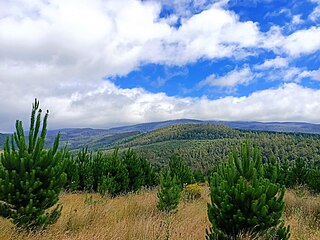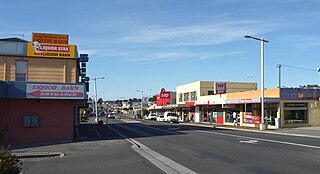Councils of Tasmania are the 29 administrative districts of the Australian state of Tasmania. Local government areas (LGAs), more generally known as councils, are the tier of government responsible for the management of local duties such as road maintenance, town planning and waste management.

Central Coast Council is a local government body in Tasmania, situated in the north-west of the state between Burnie and Devonport. Central Coast is classified as an urban local government area and has a population of 21,904, Ulverstone and Penguin are the two primary towns of the region.

Tasmania, the largest island of Australia, has a landmass of 68,401 km2 (26,410 sq mi) and is located directly in the pathway of the notorious "Roaring Forties" wind that encircles the globe. To its north, it is separated from mainland Australia by Bass Strait. Tasmania is the only Australian state that is not located on the Australian mainland. About 2,500 kilometres south of Tasmania island lies the George V Coast of Antarctica. Depending on which borders of the oceans are used, the island can be said to be either surrounded by the Southern Ocean, or to have the Pacific on its east and the Indian to its west. Still other definitions of the ocean boundaries would have Tasmania with the Great Australian Bight to the west, and the Tasman Sea to the east. The southernmost point on mainland Tasmania is approximately 43°38′37″S146°49′38″E at South East Cape, and the northernmost point on mainland Tasmania is approximately 40°38′26″S144°43′33″E in Woolnorth / Temdudheker near Cape Grim / Kennaook. Tasmania lies at similar latitudes to Te Waipounamu / South Island of New Zealand, and parts of Patagonia in South America, and relative to the Northern Hemisphere, it lies at similar latitudes to Hokkaido in Japan, Northeast China (Manchuria), the north Mediterranean in Europe, and the Canada-United States border.

Tyenna is a rural locality in the local government area (LGA) of Derwent Valley in the South-east LGA region of Tasmania. The locality is about 44 kilometres (27 mi) west of the town of New Norfolk. The 2016 census recorded a population of 43 for the state suburb of Tyenna. It is a settlement on the Tyenna River in Tasmania, located 81 kilometres (50 mi) west of the state capital, Hobart and is currently but a remnant of a once thriving rural community.
Glenlusk is a rural locality in the local government areas (LGA) of Derwent Valley (6%) and Glenorchy (94%) in the South-east and Hobart LGA regions of Tasmania. The locality is about 8 kilometres (5.0 mi) west of the town of Glenorchy. The 2016 census recorded a population of 200 for the state suburb of Glenlusk. It is a semi-rural suburb of Hobart. It is west of Chigwell.
Blackstone Heights is a rural/residential locality in the local government areas (LGA) of Meander Valley (97.5%) and West Tamar (2.5%) in the Launceston LGA region of Tasmania. The locality is about 34 kilometres (21 mi) east of the town of Westbury. The 2016 census recorded a population of 1270 for the state suburb of Blackstone Heights. It is an outer suburb of Launceston.

Granton is a rural residential locality in the local government areas (LGA) of Derwent Valley (80%) and Glenorchy (20%) in the South-east and Hobart LGA regions of Tasmania. The locality is about 9 kilometres (5.6 mi) north of the town of Glenorchy. The 2016 census recorded a population of 1736 for the state suburb of Granton. It is a suburb of Hobart. Rust Road is the approximate boundary between the two municipalities at Granton.
Dodges Ferry is a rural / residential locality in the local government area (LGA) of Sorell in the South-east LGA region of Tasmania. The locality is about 13 kilometres (8.1 mi) south-east of the town of Sorell. The 2016 census recorded a population of 2467 for the state suburb of Dodges Ferry.
In the state of New South Wales, Australia, there are many areas which are commonly known by regional names. Regions are areas that share similar characteristics. These characteristics may be natural such as the Murray River, the coastline, or the Snowy Mountains. Alternatively, the characteristics may be cultural, such as a viticulture land use. New South Wales is divided by numerous regional boundaries, based on different characteristics. In many cases boundaries defined by different agencies are coterminous.

Kings Meadows is a residential locality in the local government area (LGA) of Launceston in the Launceston LGA region of Tasmania. The locality is about 5 kilometres (3.1 mi) south of the town of Launceston. The 2016 census has a population of 3670 for the state suburb of Kings Meadows. It is a suburb in the south of Launceston. Kings Meadows is located in the floor of a shallow valley, roughly 70m above sea level, which drains NE towards the small suburb of Punchbowl. Main access to the suburb from the CBD is from Hobart Road via the minor suburb of South Launceston. Kings Meadows High School is located in this suburb.
Youngtown is a residential locality in the local government areas (LGA) of Launceston and Northern Midlands in the Launceston and Central LGA regions of Tasmania. The locality is about 23 kilometres (14 mi) south-east of the town of Launceston. The 2016 census has a population of 291 for the state suburb of Youngtown. It is a southern suburb of Launceston. There is a football ground at Youngtown, the Youngtown Oval, which is where South Launceston Football club play their home games in the Tasmania State League. Youngtown Primary School is also located in the suburb.
Punchbowl is a residential locality in the local government area (LGA) of Launceston in the Launceston LGA region of Tasmania. The locality is about 4 kilometres (2.5 mi) south-east of the town of Launceston. The 2016 census recorded a population of 463 for the state suburb of Punchbowl. It is a very small suburb of Launceston.
Travellers Rest is a rural/residential locality in the local government areas (LGA) of Meander Valley (98%) and Northern Midlands (2%) in the Launceston and Central LGA regions of Tasmania. The locality is about 24 kilometres (15 mi) east of the town of Westbury. The 2016 census recorded a population of 305 for the state suburb of Travellers Rest. It is a settled semi-rural area at the edge of Greater Launceston.

Conara is a rural locality in the local government area (LGA) of Northern Midlands in the Central LGA region of Tasmania. The locality is about 50 kilometres (31 mi) south-east of the town of Longford. The 2016 census recorded a population of 130 for the state suburb of Conara.
Pelverata is a rural locality in the local government areas (LGA) of Huon Valley and Kingborough in the South-east and Hobart LGA regions of Tasmania. The locality is about 22 kilometres (14 mi) south-west of the town of Kingston. The 2016 census recorded a population of 206 for the state suburb of Pelverata. It is a town in Tasmania, Australia, to the east of Huonville. It is mainly in the Huon Valley Council area, with about 4% in the Kingborough Council LGA.
Oyster Cove is a semi-rural locality in the local government areas (LGA) of Kingborough and Huon Valley in the Hobart and South-east LGA regions of Tasmania. The locality is about 20 kilometres (12 mi) south-west of the town of Kingston. The 2016 census has a population of 319 for the state suburb of Oyster Cove.
In South Australia, one of the states of Australia, there are many areas which are commonly known by regional names. Regions are areas that share similar characteristics. These characteristics may be natural such as the Murray River, the coastline, desert or mountains. Alternatively, the characteristics may be cultural, such as common land use. South Australia is divided by numerous sets of regional boundaries, based on different characteristics. In many cases boundaries defined by different agencies are coterminous.
Quoiba is a rural residential locality in the local government area (LGA) of Devonport in the North-west and west LGA region of Tasmania, about 5 kilometres (3.1 mi) south of the town of Devonport. The 2021 census recorded a population of for the state suburb of Quoiba. It is a residential and industrial suburb located on the south western side of the Mersey River.
Middlesex is a rural locality in the local government areas (LGA) of Meander Valley, Central Coast and Kentish in the Launceston and North-west and west LGA regions of Tasmania. The locality is about 40 kilometres (25 mi) south-west of the town of Sheffield. The 2016 census recorded a population of 4 for the state suburb of Middlesex.






